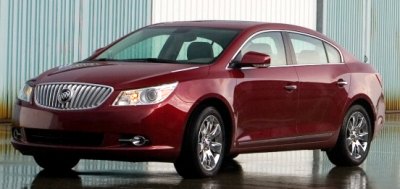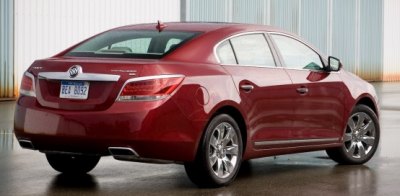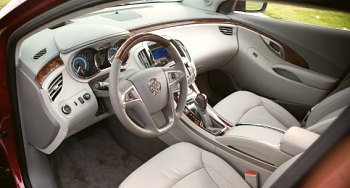Buick LaCrosse
Debut: 2009 |
||||||
Until recently Buick was still seen as an aging brand serving conservative customers in retirement age. Its cars were mostly crap, offering vast of metal in tasteless shape and poor quality, using ancient pushrod engines and outdated suspensions to achieve bargain prices. Unfortunately, demand for Buick dried out as most of those old customers had died. The old era went into history together with the old General Motors. In the new age, everything starts all over again. Brands and product portfolio are rationalized. Platform strategy is simplified. Old mechanicals phased out. New school styling phased in. Strictly speaking, the first “new age Buick” was Enclave, an SUV launched in 2007. In the car side, it begins with the new LaCrosse. A first glance at the new Buick LaCrosse arises a suspicion: is it really a Buick? Yes, it retains the trademark waterfall grille, but that is about the only thing linking to the past. This stylish and sporty exterior design was penned by someone whose vision falls in Europe. It combines a functional shape with a sense of understated elegance rarely found in Detroit. It has none of the flamboyant or muscular features of traditional American designs. On the contrary, it has some very subtle details, such as the Bentley-style crease line running around the rear wheelarch.
Forget about its American roots. The new Buick is a product of international cooperation. Opel of Germany contributed its Epsilon II platform and provided fundamental engineering. American designers located at Warren penned its exterior design; But most significant of all, its interior design was done by Chinese designers located at Shanghai. Having seen the gorgeous Buick Riviera concept in 2007, people no longer doubt the competence of GM's Chinese designers. Especially now China has passed USA as the biggest market of Buick, employing some Chinese flavors will benefit its sales. The LaCrosse is to be assembled at two plants - Oshawa of Canada and Shanghai (in the joint-venture with SAIC), with the latter taking the majority. The interior design looks stylish, elegant and luxurious from the first sight. Features like blue-glowing instrument and chromed center console catch your eyes. Spend more time with it, however, you may find it too showy, lacking the understated beauty of the exterior. Like most Chinese products, its visual quality is skin-deep. The flowing shape sacrifices storage spaces and makes the door handles useless. Fit and finish falls short of the standard of premium cars. The same goes for materials - there are fake leather and wood, some soft plastics but also many hard plastics. It's easier to satisfy farmers-turn-tycoons Chinese than well-educated Western executives. Space-wise, LaCrosse is more than competitive, especially its back seats. A long wheelbase enables generous legroom for rear passengers. This is especially important in the China market because many of the Buick will be bought as company cars to take bosses and VIPs.
The underpinnings come from Opel Insignia. Wheelbase has been stretched by a full 100 mm to 2837 mm to suit its near-luxury market positioning. With a length just over 5 meters and a kerb weight up to 1843kg, this is the first Epsilon II car falling on the E-segment. A rigid chassis and extensive NVH engineering such as triple door seals, laminated glass and 6-point engine mounts result in good refinement. On the run, the cabin is remarkably quiet. The strut and multi-link suspension is absorbent without floating. Its setup is slightly softer than the European car, but it still controls the body movement million miles better than Buicks of the old. Like Insignia, you can opt for an electronic adaptive damping to improve control further. However, the car is not designed for sporty drivers. Push it beyond 8/10 and the front-wheel drive chassis will understeer. The electrical power steering is accurate but numb. The 6-speed automatic box is a tad slow in reaction. All these mean the Buick is more a rival to Lexus than BMW. Performance is another weakness. GM offers three engines for the car – 182hp 2.4-liter four-pot, 255hp 3.0-liter V6 and 280hp 3.6-liter V6. Although the V6s are equipped with variable valve timing and direct fuel injection, they fail to deliver competitive performance and fuel economy. This is because the LaCrosse is really heavy - carrying some 200 kilograms more than an equivalent Mercedes E-class ! The smaller V6 lacks low-down grunt as it takes 5100 rpm to find peak torque. The larger engine is 24 horses short of the same unit used in Cadillac CTS. It takes 7 seconds to go from rest to 60 mph, half a second adrift of class norm. Moreover, the 3.6-liter engine could induce some torque steer if you are hard on throttle. Ridiculously, LaCrosse offers a Haldex 4WD system as option only on the 3-liter car, leaving the more powerful engine on front-wheel drive. Nevertheless, the V6 engines are smooth and refined, especially the smaller one. They suit the civilized character of the car very well. If you can live with its interior and performance, Buick LaCrosse can be a decent alternative to Japanese near-luxury cars. It just isn’t as good as it looks. |
||||||
| The above report was last updated on 24 Jul 2009. All Rights Reserved. |





